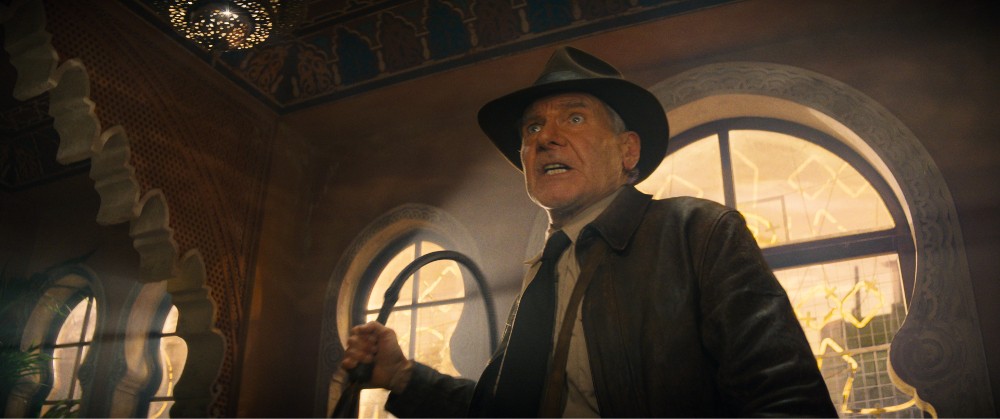
When James Mangold was announced as the director of the final Indiana Jones film, it was a no-brainer that Phedon Papamichael, ASC would join him. The director and cinematographer have collaborated on several films going back to Identity in 2001.
Papamichael, who’s also worked frequently with Alexander Payne and George Clooney, follows up the look established by Douglas Slocombe and Janusz Kamiński while also adding his own style to the franchise. Papamichael last spoke with BTL a few years ago for The Trial of the Chicago 7, and the Sorkin-directed film would earn him his second Oscar nomination—his first nomination was for working on Alexander Payne’s Nebraska.
In Indiana Jones and the Dial of Destiny, Harrison Ford reprises the role of legendary archaeologist Indiana Jones for the fifth and final big-screen adventure as he dons the fedora and whip for the last time. Recently, Papamichael spoke with Below the Line about his experience crafting Indy’s final adventure.
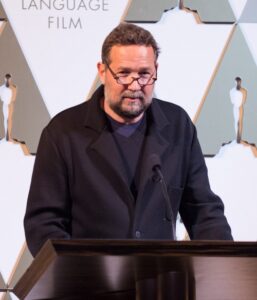
Below the Line: It’s so good to see you again. How are you doing?
Phedon Papamichael: I’m good. I’m good. I’m chilling in Athens. We were prepping the new James Mangold film with Timothée Chalamet as Bob Dylan in A Complete Unknown. We were in New York and like everyone else, we’re on unexpected holiday.
BTL: Hopefully everything gets resolved soon.
Papamichael: Yeah. Where it is, it won’t be that soon.
BTL: How soon did James Mangold reach out to you after he was announced as the director of Indiana Jones and the Dial of Destiny?
Papamichael: I don’t know, two minutes? [laughs] I don’t know. We talk all the time so I was aware of that being a possibility. He had been working on the script for a while. He told me that Steven signed over the torch to him but of course, Steven was involved as executive producer and that he liked where James was taking the script. Harrison also was enthusiastic about it. I knew all along that it’s probably going to happen.
Of course, it came together during the height of Covid so then it was about, when do we go to the UK? Where do we shoot it? We had a whole lineup of locations that were being scouted remotely. One included India, Rajasthan. which ended up being the Morocco sequence because just as we were going to go to India, it was peaking there. It was low in Morocco, so we flipped everything around. We scouted Morocco—Adam Stockhausen, the production designer, and I.
Ironically, when time came to travel, it was peaking in Morocco and it was sort of diminishing in India. But anyway, it was very challenging because of all these variable factors. Also, Harrison having a shoulder injury in the middle of the shoot. It was a marathon just getting this whole thing done. I think when you see the movie, you realize how much work has been put into that.
But yeah, we ended up shooting in Scotland, Glasgow doubled for New York, then of course, a lot in Pinewood and all the stage work, and then location work in Sicily and in Morocco, and then back to Pinewood to fill in all the missing pieces that we couldn’t get on location, especially the tuk-tuk sequence that takes place in Morocco. That was mostly shot by second unit, all the action, wide shots, and then we shot all the actors to integrate them into that sequence back in Pinewood.
It was a technically very challenging. We had our hands full. We had approximately 180 shoot days and then there was a second unit that Patrick Loungway was the cinematographer and then we actually kept him on. Even back in London, we had Patrick on. We had Cory Geryak, who came on. Initially, he was a gaffer of mine way back on Identity but also for Wally Pfister on Inception and all that but he’s a cinematographer now. I brought him as additional camera.
Everybody got their own little unit. We were just on multiple stages at the same time trying to get this thing done because we had multiple little shutdowns because of Covid. It was just a lot of extras—especially that hotel where the auction takes place in Morocco. That set was in London. The exterior was in Morocco in Fez. That was a big sequence with tons of extras and every time somebody got it, we had to shift sets. It was logistically very challenging because we have to leave a lot of sets up on 5-6 different stages in Pinewood, including the 007 stage, a big one, because we had to go back and revisit them all the time so we couldn’t really strike them.
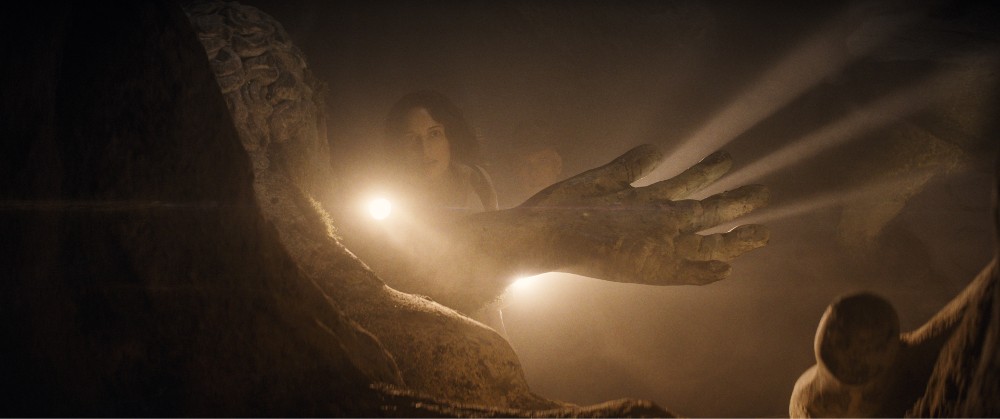
BTL: Indiana Jones is an established franchise going back to 1981 with Raiders of the Lost Ark. How do you stay true to the franchise look while also adding your own style as a cinematographer?
Papamichael: Well, this is a franchise that we all grew up with and are familiar with. I mean, a lot of our crew—I mean, I’ve had several people say, “Well, I got into the film business because of Raiders.” It’s a challenge, but also, I embraced it and was very looking forward to it, also to try something lighting-wise and stylistically that is not my first instinctive approach to how I photograph stories, which I always like to be a little more subtle and less stylized in a way but looking back at Douglas Slocumbe’s work and Janusz Kamiński is a very good friend of mine, who I’ve known for 35 years and shot Crystal Skull. He used to work with me. He was my gaffer at Roger Corman’s. I called him and I go, “What is it like doing one of these things?” He goes, “Oh, it’s the hardest thing I ever did.”I have to agree with him.
It is very hard because—although it’s not so much of a stretch for Mangold and I because we think of ourselves as classic Hollywood filmmakers and we tackle different genres. Ford vs. Ferrari technically is also an action movie, but it’s always centered and we focus on the characters and the subtleties of the interactions between the characters. In Indy, it’s very similar. It’s all about the charm and the humor of Indiana Jones and the interaction with his collaborators. Of course, Phoebe Waller-Bridge being a great comedic actress, but also very smart and very good about the writing and the dialogue.
The challenge is, everyone is in constant motion. They’re running, they’re in action sequences, but we’re not just doing an action movie. It’s about capturing all the little finesses of the character interactions, and that’s something we like doing. Of course, a movie like this, you have to pre-viz and storyboard and that’s also not really something—I mean, we do it, of course, because a movie of this scope, you can’t budget even or determine what will be the effects and but we like to still be very reactive on the set.
The way I work with Mangold—this was our sixth collaboration—we like to bring the actors, we like to block it, we like to see what they do physically—their body language—and especially when you have Harrison, Phoebe, and Mads Mikkelson, who’s also amazing physically. We always like to first explore being on the set and then we create a shot list and we decide our coverage. There’s still a lot of—not improvisation, but it’s still a lot of room that we allow to take advantage of what the actors bring us although it’s a very designed and structured movie.
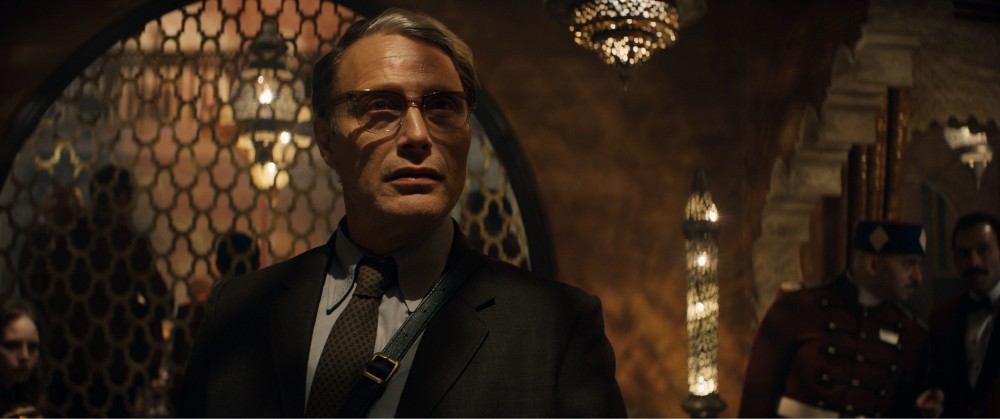
Our approach to this wasn’t that different from when we normally work together but in terms of lighting, I was happy to embrace some of the more stylized choices, use more atmospheric smog as normal part of backlights, warmer lights, beams, references to bit harder lighting, playing with the shadows, with the silhouettes, the hard shadows, projections on the wall, and that was all fun. As Kathy Kennedy said to me, “Don’t get too precious with the lighting because Steven always said this is a B movie. It’s a B movie franchise so embrace that.” We do and we’re, I think, very much in the spirit of it. Of course, I can’t do something that’s completely not logical in terms of the lighting approach. I always try to still make it look not completely unmotivated so there’s some of my own style is, I’m sure, reflected in it.
In terms of how we shoot and move the actors into camera moves, we always do traditional. We like dollies, we’d like sliders, we don’t like living on a remote head. A lot of it is very similar to the way Spielberg shoots anyway. My collaboration with Mangold—we look at movies like Catch Me If You Can and we always like the way it’s covered, Bridge of Spies, not just the Indy franchise. But even Indy, it’s something that it comes in a way that’s natural to us. It’s not like we’re really straining to copy that style. It’s something we kind of like, anyway.
We have a similar approach: single camera, wider lenses, physically close to the actors. We don’t try to just hose things down with multiple cameras and then put it all together. We’re pretty specific about our shots, we understand our editorial patterns, we know where what shot will play in the sequence, and we don’t just randomly move camera. It’s pretty designed because Jim and I have very similar sensibilities and taste about how to shoot something like this.
And again, it’s really important that we also very much like Spielberg’s work and classic Hollywood filmmaking. This is a historic franchise and it’s a great honor and very exciting to be part of this. It’s kind of part of history. We know it’s gonna be Harrison’s last appearance as the character, and I’m very honored to have been part of it.
BTL: I thought that opening sequence, where Harrison Ford is de-aged, along with the parade and chase sequence through the subway station were two of the best set pieces in the film. How’d you pull those off?
Papamichael: Yeah, that opening sequence—the whole castle in the beginning, that’s in Scotland and that’s all location. I must say, sure, a lot of it was done on stage, but this is a movie that’s really location movie. I mean, a fan could theoretically travel to all the locations that were used and stand at a certain spot and say, “This is where this was shot, this is where this is shot.” It’s not like a fully seated CG—we do have a lot of add-ons in the background, but everything was shot on location and natural light. Only elements were comped in and then coverage was shot with plates that were generated on location. That sequence in the castle and then the train, of course, the whole train sequence, we also did have a real train that was moving.
There are sequences, of course, that are done on stage, where we built the wagons, especially the train roof, but yeah, that was one where we really wanted to create a feeling that this could be lost footage from a Raiders movie, something that Steven did 30-40 years ago and it never made a cut. It was great to design something like that and really pay tribute to the whole franchise.
The subway sequence, like I said, all the street work was done in Glasgow. Adam Stockhausen, again, amazing job dressing that and all the extras and creating New York, ticket tape parade, and astronauts but then once they go underground, that was on the 007 stage. The building had two subway stations with a functioning train. The 007 stage is huge but we even had to extend it so the train could pull into the station and was functioning. When the train is chasing him down the tracks, all of that was done practical. It’s incredible detail in terms of texture and production design.
It was nice transitioning from the World War II look into New York in the 60s. We were always excited about that transition. I love that shot where we find him in his lounger sleeping and waking up and then we reveal him at his current age in boxer shorts. We always knew that’s going to get quite a reaction. And sure enough, when we had the premiere at the Chinese, people just gasped and they applauded and he grabs a baseball bat. It’s just something where you have to—we don’t hide the fact that he’s in an advanced age.
I mean, he’s playing a professor on the day of his retirement. We don’t try to tiptoe around it. There’re lots of references to him being old, creaky, his joints are hurting, and he’s been shot multiple times. It was very important for us, for the audience, to really just kind of embrace him as the age that he’s portraying it in 1968-69. I think that was quite effective transition from the opening sequence.
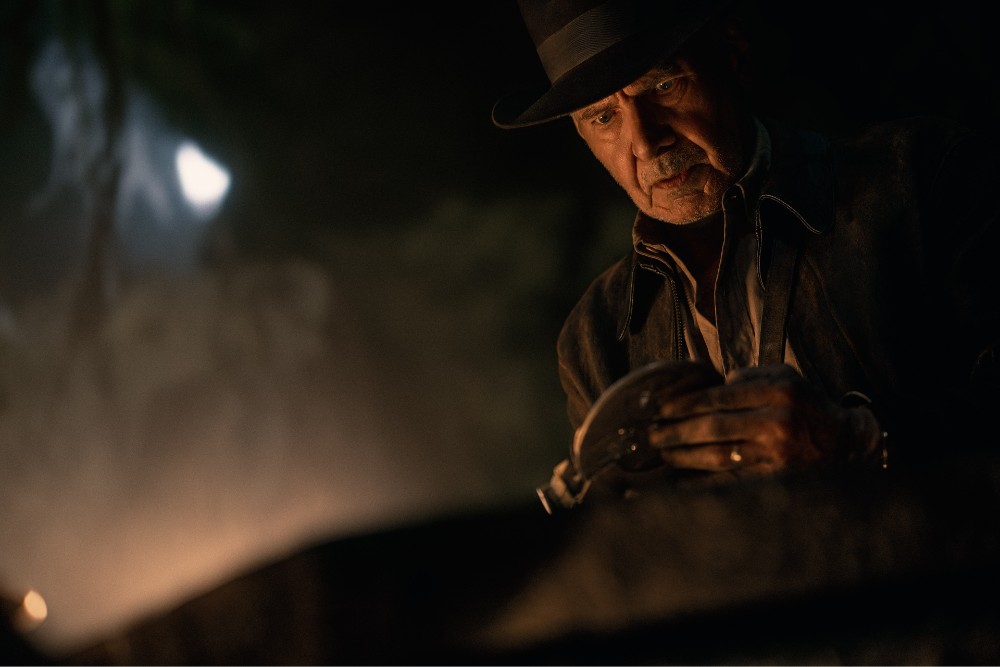
BTL: I know you mentioned earlier that the entire film was challenging, but what would you say was the most challenging scene?
Papamichael: Well, every time you’re on a boat, a train, or an airplane. The World War II bomber set was very challenging because we have quite a few players in there. It was elevated maybe 20 feet high on a hydraulic rig. It starts at night. It comes through a heavy storm, exits this vortex and goes diving into the sunny Sicilian landscape. That was very challenging because I had to have a lot of moving lights or have hard lights on cranes, creating the sun patterns that are moving inside the plane, I had to change the ambiance.
We didn’t really have footage. We didn’t really use LED Volume-style walls to feed in anything because none of that had been created yet. It was always challenging reassuring myself with VFX supervisor Andrew Whitehurst, okay, what are we going to do here? What is actually going to be in the background? I’m shooting the beach in Syracuse and the Romans are attacking. We are actually on a beach and there were set pieces of the fortress and all that and we had extras, but of course, not to the extent of what it’s going to be in the final.
We got unlucky with the weather. It was raining and we would sit in our little tents and it would stop raining for five minutes, we’d go out shoot a little piece, and then it started. I kept saying, “I’m gonna light it like sun in the foreground.” I’m putting the actors in hard light because I’m assuming when we generate this—the elements in the background—you can give me patches of light and we can have clouds that justify that we’re going in and out of sun. It’s all very theoretical at that point, really, to balance the levels right and see how it’s going to play in the final composite of all things. That’s the most challenging thing. I’d rather just shoot a real location, real time and deal with adjusting for the changing lighting conditions without having all these additional elements that are going to be created later.
On Ford vs. Ferrari, we had similar challenges. I think they were solved very nicely because the race—24 hours of Le Mans—takes obviously over a 24 hour period but we have lots of changing lighting conditions and they were handled very well. This one is a little bit more just because it’s the period of 300 BCE and where are the ship’s gonna be and where are the Romans—it’s also harder to get explained and imagine what exactly is going to be put in, how long will the city extend for along the coastline, and all these things. It’s a little bit of a guessing game and you hope that you provide the best elements for the VFX team to work with later.
I think, in general, those were the most challenging, the plane, on that beach, and final sequence. The tuk-tuk, also, because it’s stuff that is shot by another unit months before. You have to go with the actors and plug them all in with your shots. We’re on stage now. I’m riding this DMX, this little wireless dimmer, with 12 channel and I’m watching playback of the pre-viz and all the shots that have been shot. I’m watching the sequence as it’s assembled with what we’re shooting with the monitor that’s shooting our actors, and I’m trying to—okay, they’re in making a left turn, they come out of frontal sun into a dark alley, and I have to adjust all these because it has to cut in. That was extremely challenging, but also fun to really do something like this because I haven’t really done much of that.
I had a great crew in England and we had all the technology that we needed, but using a lot of LED lighting and a lot of these wireless dimmers that I could be very flexible, walk out of my DLT tent and actually see everything behind, and then go back and during the tape, really play it off the monitor, almost like a live mixer at a concert so it was great. It’s nice when you have a plan, but it’s all theoretical. and it’s nice when you see the final product and go, that ended up working.
Indiana Jones & the Dial of Destiny is now available via Video on Demand for digital download.





